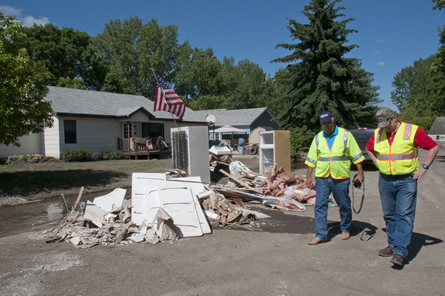
| {column0} |
| {column0} |
All events are high impact for the people affected by them. Coordinate with partners and provide information to mitigate the impact.
- Flood/Flash Flood
- Dam Failure
- Hazmat
- Drought

The office staff should maintain situational awareness.
Focus on conditions leading to significant flood or flash flood events.
Click here for a list of potential causes of flooding and flash flooding.
- Significant widespread rainfall observed or forecast.
- Significant snowmelt.
- Stationary systems or storms.
- Slow-moving storms with heavy rain.
- Rain on burn areas.
- Urban flooding.
- Low-water crossings.
- Recent wet conditions that increase flooding possibilities.
- Environmental conditions significantly wetter than normal (amount of precipitable water, warmer temperatures, etc.).
- Significant events upstream of your office.

Read Section 3.1 of NWSI 10-921 for details on forecast and warning operation tasks and actions.
Dam Failure
Dam failures take hours up to weeks to occur, depending on whether the cause is heavy rain, debris jams, or melting snow. The time from causative event to failure is also dependent on the dam type.

Review the following sections in NWSI 10-921:
- Appendix A (Dam Failure Readiness Activities) annually and if an event arises
- Appendix B (Dam Failure Rules of Thumb) and discuss this with the RFC to understand limitations of this method
- Section 3.6 and use Appendices C and D to document incidents
Best Practice: Compare the information in the National Inventory of Dams (NID) to the contents of HydroBase. Note any discrepancies and coordinate with the RFC or the dam owner to correct the information in either HydroBase or the NID.
The procedure for hazardous material (Hazmat) spills is similar to dam failure.
 Read Section 3.8 of NWSI 10-921 and use Appendix E to document hazmat incidents.
Read Section 3.8 of NWSI 10-921 and use Appendix E to document hazmat incidents.
Drought unfolds over weeks and months but is no less impactful than flooding.
Consider creating a media fact sheet with general information on drought.
Your office may be issuing additional products, answering more public and stakeholder inquiries, or providing input to drought declaration documents.

Read NWSI 10-1201, NWSI 10-1202, and related supplements for information on dealing with drought.
References: National Integrated Drought Information System (NIDIS), Drought Monitor
Instructions: Click here to display regular course navigation after viewing the interaction above.